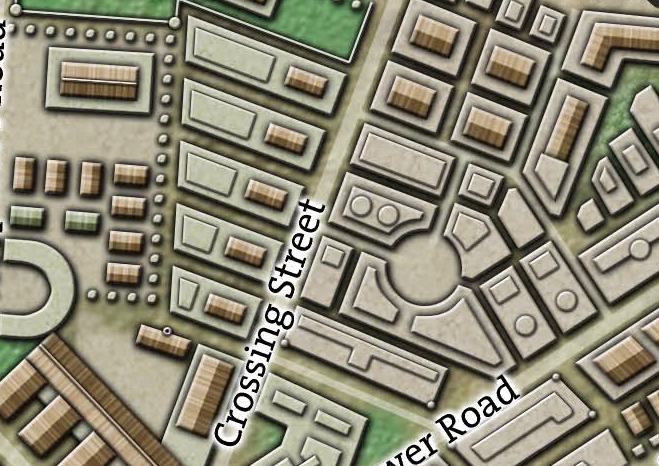If you’re a beginning GM, I encourage you to really practice framing and running roleplaying scenes using the introductory tips above. You can get a lot of mileage out of them, and you’ll honestly benefit a lot by running a dozen or more sessions like that while you get comfortable
When you’re ready to start spicing things up, though, here are a few intermediate tips you can use.
INTERMEDIATE TIP #1: ADDING CHARACTERS
First, as we’ve noted, it’s not at all unusual to have roleplaying scenes with multiple NPCs present. To get comfortable with this, I recommend starting out with no more than two major NPCs and then expanding from there. (It’s just like adding a second ball when you’re learning how to juggle.)
Being crystal clear in the NPCs’ touchstones and objectives will help a lot here.
For the touchstones, not only will their distinct mannerisms help you swap from one character to the other; it will really help the players keep track of who’s talking.
When it comes to objectives, I recommend starting out with scenes in which the two NPCs have goals which are in direct conflict with each other. This sharp distinction will not only, once again, make it easier for you to keep the two characters clear as you’re swapping between them, it will also inherently create an interesting dynamic in which the PCs will be “forced” to choose which NPC’s agenda they agree with.
Bonus Tip: It takes extra prep, but if you have a picture of each NPC, print them up as tent cards that you can display on the table in front of you or on top of your GM screen. It can really help the group keep track of all the NPCs in the scene, and you can also just reach out and lightly tap each NPC’s portrait as they speak.
INTERMEDIATE TIP #2: INCORPORATING SCENERY
When you’re just getting started, it’s okay to just stay focused on the dialogue — what your NPC is hearing and what they’re saying in response. There’s plenty of drama to be found in words.
But these conversations are not taking place in formless voids. The characters are physically present in the game world — a moldering dungeon, a sweltering swamp house, or chrome-plated neon nightclub. As the GM, it’s up to you to make sure that reality remains present in the minds of the players. It’s not enough to just talk in character; you need to periodically drop in descriptions of the environment.
It seems simple, but you may be surprised how much extra brain power it takes to make this happen. After all, your focus is going to be on the conversation; the back-and-forth of your witty repartee. It’ll be really easy to just let everything else drop away.
You’ll also find it difficult to motivate or justify these descriptive dollops: Why, exactly, are we mentioning the color of the linoleum floor again?
- Don’t just repeat what you’ve already said. Add new details and engage new senses. If you’ve described what the interrogation room looks like, now it’s time to talk about the sickly smell in the air. If you said that there was a table in the middle of the room, maybe now you can describe how the tabletop feels sticky to the touch.
- Let the scene evolve. In busy environments, describe what background characters are doing (e.g., a maid passes through the chamber dusting, loud cheers come from the roulette table, etc.). The smell of dinner cooking might drift in from the kitchen. The light outside the window might shift or a storm roll in.
- Describe the physical actions of the NPC and connect those actions to the environment. (You can combine this with miming the actions yourself if it feels appropriate.) They pace across the cream carpet; they rap their knuckles on the conference table; they glance nervously towards the double doors.
- When you’re not sure what an NPC should say next, take advantage of the moment to re-establish the scenery. (“Tom pauses, turning to gaze into the crackling fireplace.”) This pulls double duty, not only grounding the scene back into the game world, but also buying you a moment to figure out what Tom should say.
If you’re feeling really ambitious, go for the full-blown Sorkin walk-and-talk. Perhaps the conversation is happening while the characters are riding through town on horseback, and you can periodically describe the sights they see as they ride along. Or they arrive at a party and have a conversation with the host as he leads them deeper into his mansion.
INTERMEDIATE TIP #3: ROLEPLAYING ON THE INITIATIVE COUNT
In much the same way that being immersed in a roleplaying scene can make it easy to stop describing the rest of the game world, so, too, is it easy to forget to roleplay your NPCs during other scenes.
During combat, for example, you’re often juggling all kinds of stuff while simultaneously dealing with an ultra-slow pace and the artificially stilted action sequencing of the initiative order. Even though many of our favorite fight scenes from movies and comic books are filled to the brim with dialogue, it can be really easy for an RPG fight scene to play out like a silent film.
If this is true for you, too, then leverage the initiative system by giving Dialogue an initiative count separate from the NPCs: When you hit that initiative count, it’s a cue to have one or more of your NPCs say something.
For a more detailed breakdown of this technique, check out Random GM Tip: Roleplaying Initiative.
Bonus Tip: Once you get a conversation running in-tandem with your fight scenes, it’s an opportunity to give your character’s an objective other than “kill the other guy,” For example, maybe they want to get information from the PCs (how did they find us? or where is the Ruby Ark?). This adds a whole extra dimension of drama and interest to the scene.
INTERMEDIATE TIP #4: BUILDING RELATIONSHIPS
Over the course of a campaign, you’re going to have a lot of roleplaying scenes, many of which will likely feature NPCs that the PCs have interacted with before. Ideally, the PCs (and their players) will begin developed relationships with NPCs over time.
To help foster and develop these relationships, it’s important that your NPCs also change and grow over time. If they’re the exact same cardboard cutout every time the PCs talk to them, they’ll never feel like “real” people and the players will never invest in them. Relationships, by their very nature, must build over time.
Obviously, every relationship is unique and how it develops over time will depend on what actually happens during play. But here are two rules of thumb that can help make sure they keep moving:
- Ask yourself: What is one thing this NPC has done since they last saw the PCs? This may or may not come up in conversation, but you should generally try to find an excuse to drop it in somewhere.
- Have the NPC ask the PCs what they’ve been up to since the last time they saw them.
You don’t need to shove these in immediately as soon as the scene begins. (Although they can be good icebreakers if you need one.) In fact, they’re generally more effective if you can work them organically into the flow of the conversation. (“Have I heard anything about Marc Redfern? You know, it’s funny you ask, but when I was in Berlin last week attending the peace conference…”) Note that you don’t need to preplan how you’ll incorporate them; just look for opportunities where the anecdote can usefully contextualize information or an argument or whatever the conversation happens to be about.
Bonus Tip: Also think about how the NPC’s attitude towards the PCs may have shifted since their last interaction, either due to their last interaction or because of offscreen events in the interim. (Does the NPC have different attitudes towards different PCs?)
CONCLUSION
Even with these intermediate tips, we’re still only scratching the surface of what’s possible in a great roleplaying scene: It turns out that people are complicated.
But hopefully by breaking some of that complexity down into simple, basic rules of thumb, you’ll be able to take your first steps with confidence.
When you’re ready to take things even further, check out the Universal NPC Roleplaying Template.
FURTHER READING
Prep Tips for the Beginning DM
Prep Tips for the Beginning GM: Cyberpunk
Failure for the Beginning GM
Pacing for the Beginning GM


















